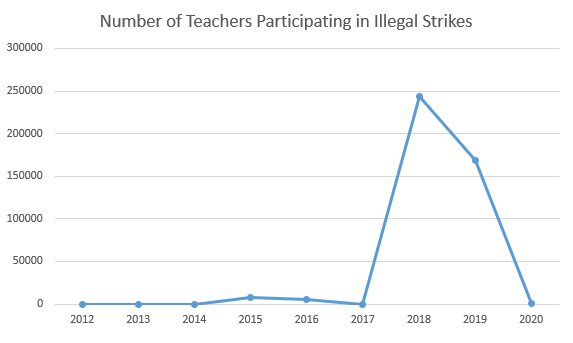
PISCATAWAY, N.J. – Teacher strikes are illegal in 35 states, but that hasn’t stopped underpaid educators from walking off the job to demand adequate school funding and long overdue raises, and it may not stop them from striking if they feel unsafe in the classroom due to COVID-19.
 Rebecca Kolins Givan, an associate professor in the Rutgers School of Management and Labor Relations and co-editor of the upcoming book Strike for the Common Good, analyzed data on every teacher strike in the U.S. going back to 2012. She found that at least 46 percent of the strikes were illegal in the state where they took place, including the 2018 West Virginia strike that touched off the #Red4Ed movement and sparked a wave of illegal strikes nationwide.
Rebecca Kolins Givan, an associate professor in the Rutgers School of Management and Labor Relations and co-editor of the upcoming book Strike for the Common Good, analyzed data on every teacher strike in the U.S. going back to 2012. She found that at least 46 percent of the strikes were illegal in the state where they took place, including the 2018 West Virginia strike that touched off the #Red4Ed movement and sparked a wave of illegal strikes nationwide.
“If there’s one thing we’ve learned since West Virginia, it’s that teachers are not afraid to walk out,” Givan said. “Strikes are contagious. A successful strike emboldens teachers in other states, cities, and school districts, leading to more strikes and stronger demands. Teachers know that they can use their collective voice to advocate for high quality schools, whether they’re fighting for adequate funding or standing up for safety during a pandemic.”
Teacher strikes are legal in 13 states: Alaska, California, Colorado, Hawaii, Illinois, Louisiana, Minnesota, Montana, Ohio, Oregon, Pennsylvania, Utah, and Vermont. Their legality is contested in two states, South Carolina and Wyoming. Teacher strikes are illegal in the remaining 35 states and Washington D.C. Givan’s analysis found:
- There have been 92 strikes in 21 states since January 1, 2012.
- More than 672,000 teachers walked out, affecting 6.7 million students.
- Close to half of the strikes, 42, were illegal in the state where they took place.
- More than 80 percent of the illegal strikes (35 of 42) occurred in 2018 and 2019, beginning with West Virginia.
- About 412,000 teachers participated in illegal strikes in 2018 and 2019, compared to fewer than 14,000 for the previous six years combined.

|
Striking teachers won significant victories—increases in school funding including resources to hire additional nurses and social workers, raises for teachers and support staff, reductions in class size—but they took great risks to do so. The penalties for an illegal strike vary from state to state, ranging from ambiguous to severe. However, illegal strikers in 2018 and 2019 were seldom punished for walking off the job, sending the signal to teachers elsewhere that strikes can be a successful tactic.
Becky Pringle, the incoming president of the National Education Association, the largest union in the U.S., told Chalkbeat she would support local strikes and protests over teacher safety during COVID-19. Randi Weingarten, president of the American Federation of Teachers, called for “safety strikes” as a last resort to protect educators from the coronavirus. And Michael Mulgrew, president of the United Federation of Teachers, is not ruling out a “job action” by New York City teachers if their safety demands are not met.
“The credible threat of a strike is often just as powerful as a strike,” Givan said. “The recent wave of strikes forces administrators, school boards, and elected officials to take a credible strike threat seriously. They’ve seen teachers walk out all over the country. They know it can happen again.”
The 21 states where strikes have occurred since January 1, 2012 are: Arizona (2), Arkansas (1), California (11), Colorado (4), Illinois (12), Indiana (1), Kentucky (3), Massachusetts (1), Michigan (3), Minnesota (1), New Jersey (2), North Carolina (2), Ohio (2), Oklahoma (1), Oregon (1), Pennsylvania (16), South Carolina (1), Tennessee (1), Vermont (2), Washington (23), and West Virginia (2).
Press Contact
Steve Flamisch
Rutgers School of Management and Labor Relations
848.252.9011 (cell)
steve.flamisch@smlr.rutgers.edu
About the Book
Strike for the Common Good, co-edited by Givan and Amy Schrager Lang, and featuring the voices of numerous educators, is due to be published by University of Michigan Press in October. The book explores the recent wave of teacher strikes that swept the nation, including the “common good” strikes in Los Angeles and Chicago where teachers emphasized issues of racial justice and the ongoing defunding of public education.
About the School
The Rutgers School of Management and Labor Relations (SMLR) is the world’s leading source of expertise on managing and representing workers, designing effective organizations, and building strong employment relationships.
###


